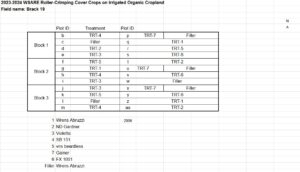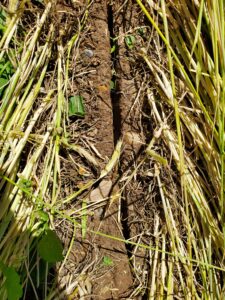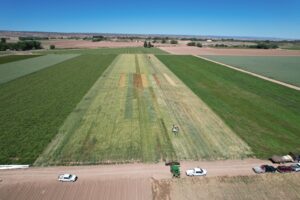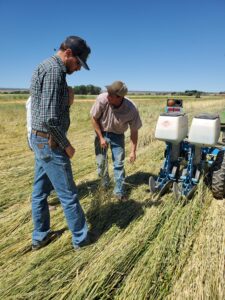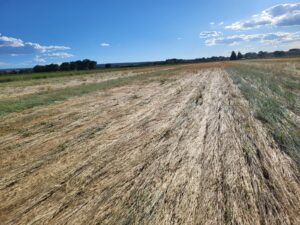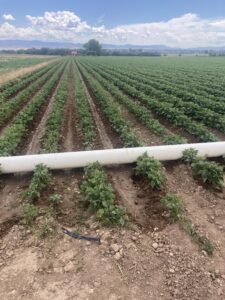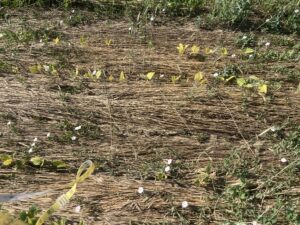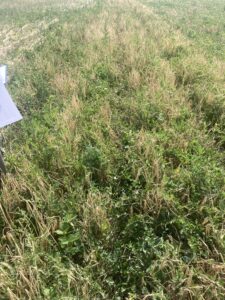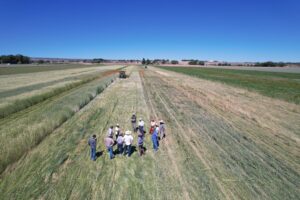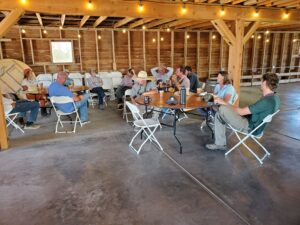Progress report for FW23-424
Project Information
One of the main issues with organic cropping systems is tillage-reliance. Tillage can contribute to soil erosion, which has negative impacts on soil health and farmers’ long-term livelihoods. Alternatively, no-till systems help prevent soil loss, and lessen labor and fuel costs for farmers.
This project aims to abate the tillage-reliance common in organic systems by researching adaptation of organic no-till systems common in the Midwest and North-Earth in the Western Slope region of Colorado. To determine best practices in the dry West, this project will:
(1) Determine the best performing winter cereal grain to use as the rolled-down mat by testing multiple varieties of winter rye, winter barley and winter triticale.
(2) Determine the optimal planting dates of the winter cereal grain by comparing two dates between September 15 and October 15.
(1) and (2) will be assessed through UAV imagery, tiller count, and weight of above ground cereal and weed biomass.
(3) Assess the differences in water use efficiency and weed control under tilled and no till organic systems.
(4) Assess the impact of no-till practices on crop yield.
The significance of the findings from this project will help farmers adapt no-till organic systems to minimize erosion, strengthen soil structure, and improve agronomic outcomes compared to full till systems.
The progress and results from this project will be disseminated among other ag stakeholders through a series of public facing events and extension-type publications in local ag-media and through peer to peer networking.
Research objectives:
1 - Determine best performing species and varieties of winter cereal grain to use as a rolled-down mat in the Western Slope region of Colorado.
2 - Determine best planting date of winter cereal grain
3 - Determine impact of no-till practices on crop yield.
4 - Measure water use efficiency and infiltration as influenced by rolled-down cereal
5 - Compare weed control under tilled and no-till organic pinto bean production
Education objectives:
1 - Expose local public, farmers/ ranchers and ag professionals to organic crop production.
2 - Expose local ag professionals and farmers/ ranchers to technical service provider - grower research collaboration.
3 - Provide organic crop farmers in the Western slope with relatable research results.
4 - Strengthens and expand organic grain grower and ag-professionals community around group-learning.
|
Date |
Activities |
Team members |
|
July-August 2023 |
Finalize research plots layout |
Léa Vereecke, David Harold, Patrick O’Neil |
|
September 2023 |
Plant cover crop |
David Harold |
|
March 2024 |
Cover crop visual assessment and tiller count |
Léa Vereecke, David Harold |
|
May 2024 |
Collect cover crop biomass |
Léa Vereecke, David Harold, Bridget Gilmore, Intern |
|
June 2024 |
Terminate rye and plant pinto beans |
David Harold |
|
August 2024 |
Collect weed and dry edible beans biomass |
Léa Vereecke, David Harold, Bridget Gilmore, Intern |
|
September 2024 |
Plant cover crop for 2025 plots |
David Harold |
|
October 2024 |
Harvest |
David Harold |
|
Winter 2024/ 2025 |
Analyze data and share through
|
Léa Vereecke, David Harold, Bridget Gilmore, Patrick O’Neil |
|
March 2025 |
Cover crop visual assessment and tiller count |
Léa Vereecke, David Harold |
|
May 2025 |
Collect cover crop biomass |
Léa Vereecke, David Harold |
|
June 2025 |
Terminate rye and plant pinto beans |
David Harold |
|
July 2025 |
Field day at David Harold’s farm |
David Harold, Léa Vereecke, Bridget Gilmore, Patrick O’Neil |
|
August 2025 |
Collect weed biomass |
Léa Vereecke, David Harold, Bridget Gilmore, Patrick O’Neil |
|
October 2025 |
Harvest |
David Harold |
|
Winter 2024/ 2025 |
Analyze data and share through
|
Léa Vereecke, David Harold, Patrick O’Neil |
Cooperators
- (Educator)
- - Producer (Researcher)
- (Educator and Researcher)
- - Technical Advisor (Educator and Researcher)
Research
Objective 1 - Determine best performing species and varieties of winter cereal grain to use as a rolled-down mat in the Western Slope region of Colorado.
Several varieties of winter rye, winter triticale, winter wheat and winter barley have been used in organic no-till pulse studies. However, as suggested by a review published by Vincent-Caboud et al, in 2019, “future research should focus on (i) screening species and cultivars to identify cover crop and crop combinations that optimize cropping system performance [...].”. A research paper published by the same authors in 2019 showed differences in soybean yield and weed emergence with various winter rye and winter triticale varieties, which had produced comparable biomass amounts.
At David Harold’s farm, in addition to a tilled plot for control, we will plant multiple varieties of cereal rye, winter barley and triticale.
Protocol, Year 1, 2024
1/ Fall cover crop assessment, October 13, 2023
One rep per plot:
- Total Stems (Culms+Tillers) / 3' Drill Row
- Stems as Tillers / 3' Drill Row
- Stems as Culms / 3' Drill Row
- Stage of Growth Tillers (excluding Culm)
- Stage of Growth Culm
- Plants / 3' Drill Row
- Rooting Extent (in)
2/ Spring Cover Crop Assessment
2.1/ February 18, 2024
One rep per plot:
- Total Plants per 6.75" Drill Row
- Total Stems (culm + tillers) Emerged per 6.75" Drill Row
- Mass of Leaves + Roots (g) per 6.75" drill row
- Stage of growth
2.2/ April 2024
- Stand evenness, assessed with computing the greenness from UAV imagery
2.3/ April 10, 2024
3 reps per plot, 5 plants per rep:
- Stage of growth
- Height
- Number of erect or elongating tillers
- Overall weed pressure of the plot, very low, low, medium, high, very high.
2/ Biomass at termination, according to a review by Silva and Delate, 2017 a good stand will exceed 8,000 kg of dry matter of winter cereal per hectare.
May 2024 - Clipped above ground winter cereal biomass, air dried it, and weighed samples
3/ Weed control will be assessed in August of each growing season. PI, TA, Educator and Intern will clip above ground weed biomass in random plot places (including tiller control), air dry it on farm and weigh samples.
Weed control was not systematically assessed in 2024.
Objective 2 - Determine best planting date of winter cereal grain
A determining factor in obtaining 8,000 kg per ha of winter cereal, or more, at the time of planting is the cereal planting date. A study by Mirsky et al showed that winter cereal cover-crop biomass increased approximately 2,000 kg of dry matter per ha from latest to earliest fall planting dates (August 25-October 15).
Olathe CO, is qualified as a USDA hardiness zone 6b, same as Kutztown PA, where Rodale Institute’s main farm is located. There, for a successful organic no-till soybean crop, winter cereal should be planted before October 10 (verbal communication with Dr. Andrew Smith, COO, Rodale Institute). While a later planting date is desirable to allow more flexibility in the choice of the preceding crop, planting too late will result in poor cereal stand and biomass production. At Tuxedo farm, we will plant winter cereals at a minimum of two different dates between September 15 and October 15.
To assess the performance of different seeding dates, we will use the same protocol described in Objective 1.
Objective 3 - Assess quality of cover crop termination using a roller crimper
Adequate timing of the roller-crimping has been documented as late anthesis into early milk stage: “Cereal rye biomass peaked at the late dough stage but optimal mechanical control was obtained between 50% anthesis and early milk stages.” (Keene et al, 2017). Adequate termination is critical to improve water use efficiency of the whole system. A poorly terminated cover crop will continue evapotranspiration at the crop’s detriment.
Protocol:
1/ Computing the greenness of the mat from UAV imagery taken 5,10 and 15 days after termination. Hired drone photographer will take UAV photos and TA will analyze them.
2/ Measure water use efficiency. In August, PI, TA, Educator and Intern will collect crop above ground biomass at random locations of each treatment (including the tilled control). TA will pair the crop biomass data with the water input date collected using the flow meter to calculate water use efficiency of each winter cereal.
Objective 4 - Measure water use efficiency/infiltration as influenced by rolled-down cereal
See “Relevance to sustainable agriculture” section for references on relationship between no-till into rolled-down cereal mat and water use efficiency.
Protocol:
1/ On-farm visual observation of soil surface condition: establish a rating system of surface soil moisture and assess it monthly (PI, TA and/or Educators and/or Intern)
2/ Infiltration rate using infiltration rings, monthly, PI, TA and/or Educators and/or Intern will insert infiltration rings into the soil to a depth of two inches and fill them with water to measure the rate of infiltration in the rolled-down mat and the bare soil.
3/ Protocol 2/ of Objective 3
No water measurements were made in 2024.
Objective 6 - Compare weed control under tilled and no-till organic pinto bean production
Protocol:
see Objective 1, 3/
Weed control was not systematically assessed in 2024.
2 varieties of cereal rye, 3 varieties of triticale and 2 varieties of winter barley were seeded on September 20, 2023. A 13.3’ wide drill with 6” interrow was used. The target seeding rate was 2M seed/ac, it took 76 to 185lbs/ac to get to this seeding rate depending on the specie and variety and their seed count. The previous crop was summer squash and compost was applied before planting of the cover crop.
On June 5 2024 , the cover crop was rolled-down and pinto beans planted at 100k seed/ac. 40” bed with 2 rows of beans on each bed.
All the data collected is summarized in the table below.
| Treatment | Variety | Specie | Plants/Ac (Oct 13) | Plants/Ac (Feb 18) | Stems/ac (Oct 13) | Stems/ac (Feb 18) | Leaf + root mass (g) (Feb 18) | Sig. Leaf + root mass | Root Length (in) (Oct 13) |
| 1 | Wrens Abruzzi | Rye | 2,187,680 | 2,736,213 | 4,965,840 | 21,166,933 | 51 | ab | 3.8 |
| 2 | ND Gardner | Rye | 2,710,400 | 2,581,333 | 6,611,440 | 18,740,480 | 40 | ab | 3.7 |
| 3 | Violetta | Malt Barley | 1,994,080 | 2,116,693 | 3,988,160 | 14,145,707 | 28 | ab | 4.2 |
| 4 | SB 151 | Feed Barley | 2,826,560 | 2,839,467 | 2,826,560 | 10,067,200 | 16 | b | 3.7 |
| 5 | vns beardless | Triticale | 2,255,440 | 3,252,480 | 5,343,360 | 20,650,667 | 54 | ab | 4.0 |
| 6 | Gainer | Triticale | 2,090,880 | 3,768,747 | 2,758,800 | 12,442,027 | 41 | ab | 3.4 |
| 7 | FX 1001 | Triticale | 2,178,000 | 2,632,960 | 4,936,800 | 14,403,840 | 44 | ab | 2.9 |
| 8 | Wrens Abruzzi | Rye | 2,052,160 | 3,149,227 | 4,530,240 | 18,792,107 | 75 | a | 3.1 |
| Treatment | Variety | Specie | Elongating or erect tillers/ plant (Apr 11) | Zadock stage (Apr 11) | Av. plant height (cm) (Apr 11) | Weed pressue (Apr 11) | Stage (May 7) | Stage (May 12) | Stage (May 24) |
| 1 | Wrens Abruzzi | Rye | 2.4 | 32 | 30.2 | 0.7 | Green anthers | Mid-pollination | Early milk |
| 2 | ND Gardner | Rye | 1.7 | 31 | 23.9 | 1 | Green anthers | Past mid-pollination | Mid milk |
| 3 | Violetta | Malt Barley | 2.7 | 30 | 9.3 | 2.3 | 80% headed | Early milk/ fully headed | Early soft dough |
| 4 | SB 151 | Feed Barley | 1.4 | 30 | 11.4 | 1.3 | Fully headed | Early milk | Mid soft dough |
| 5 | vns beardless | Triticale | 2.2 | 30 | 19.1 | 1 | Boot | 25% headed | Recently flowered |
| 6 | Gainer | Triticale | 2.1 | 30 | 19.1 | 2 | 50% headed | 100% headed, green anthers | Recently flowered |
| 7 | FX 1001 | Triticale | 1.4 | 30 | 15.8 | 0.3 | Boot | 50% headed | Flowering |
| 8 | Wrens Abruzzi | Rye | Green anthers | Mid-pollination | Early milk |
| Treatment | Variety | Specie | Height to flag leaf in inches (May 24) | Height to base of cover crop head in inches (May 24) | Cover crop biomass (lbs/ac) (May 25) | Pinto beans stand count (plant/ac) (July 16) | Pods per plant (Oct 9) | Seed per pod (Oct 9) | Seed per ac | Lbs/ ac | 10 pods wet weight |
| 1 | Wrens Abruzzi | Rye | 40 | 53 | 15,154 | 63,333 | 9.8 | 4.2 | 2606786 | 1931 | 63 |
| 2 | ND Gardner | Rye | 43 | 54 | 15,036 | 67,000 | 9.1 | 4.3 | 2621710 | 1942 | 63 |
| 3 | Violetta | Malt Barley | 21 | 27 | 16,237 | 57,666 | 5.3 | 3.9 | 1191956 | 883 | 66 |
| 4 | SB 151 | Feed Barley | 22 | 30 | 16,379 | 66,333 | 5.8 | 3.4 | 1308087 | 969 | 49 |
| 5 | vns beardless | Triticale | 37 | 48 | 17,023 | 66,333 | 10.5 | 5.2 | 3621782 | 2683 | 78 |
| 6 | Gainer | Triticale | 27 | 38 | 17,400 | 66,666 | 6.9 | 4.2 | 1931981 | 1431 | 65 |
| 7 | FX 1001 | Triticale | 44 | 53 | 16,514 | 65,666 | 6.1 | 3.6 | 1442025 | 1068 | 68 |
| 8 | Wrens Abruzzi | Rye | 40 | 53 | 15,154 |
- Stem per acre Feb 18: towards the end of the winter, the number of stem per acre was between 10 and 15M for SB151 and Violette barley as well as Gainer and FX 1001 triticale. It was between 15 and 20M for ND Gardener and Wrens Abruzzi Rye and finally, about 20M for VNS Beardless Triticale and Wrens Abruzzi Rye.
- Elongating or erect tillers: in the early spring, Violetta Barley had over 2.5 erect tillers per plant, both varieties of rye as well as Gainer and VNS Beardless Triticale had between 1.5 and 2.5 and FX1001 triticale as well as SB 151 Feed Barley had less than 1.5 per plant.
- Cover crop development stage: as expected, the different species did not mature at the same pace in the spring. Anthesis is the most critical stage to identify as it determines when the cover is ready for crimping. The barley varieties reached anthesis the earliest, around May 7, the following were the rye varieties which reached anthesis about a week later, around May 14 and finally the triticale varieties reached anthesis another 10 days later, around May 24. There were slight differences among species but not as marked as between species.
- Weed pressure April 11: at this stage, the weed pressure was low to very low in all the rye plots as well as in the FX1001 and VNS beardless triticale and the SB151 barley. Gainer triticale and Violetta barley exhibited higher weed pressure.
- Cover crop height May 24: both rye varieties as well as FX1001 and VNS beardless triticale were taller than the other small grains with a height at the base of the head of 48 to 54 inches. The barley varieties as well as Gainer triticale were shorter with 27-38".
- Cover crop biomass May 25: because of the wide difference in cover crop development stage at sampling, the biomass numbers can hardly be compared within the experiment. The varieties of barley were over 15 days past anthesis an had fully developed kernels which largely inflated the biomass numbers. The rye varieties were about 10 days past anthesis. The triticale varieties were sampled at optimal stage and reached a biomass of over 16,000lbs/ac which is twice as much as the minimum recommended for this system.
- Pinto bean stand count July 16: 40 days after planting, the stand of pinto bean varied from 57 to 67k seed per acre or 57 to 67% of the 100k spa planted population. The stand was below 60k in the Violette barley plots, between 60 and 65k in the wrens abruzzi rye plots and between 65 and 67k in the Sb151 feed barley, ND Gardener rye and all the triticale plots.
- Hand harvest yield estimate: the estimated yield by hand harvest was by far the highest in the VNS Beardless triticale plots with an estimated 2,683lbs/ac. Yield was between 1,700 and 1,900 in the Violetta barley and Wrens Abruzzi rye, 1,431for Gainer triticale and around 1,000 for ND Gardener rye, FX1001 triticale and SB151 barley.
Plots layout
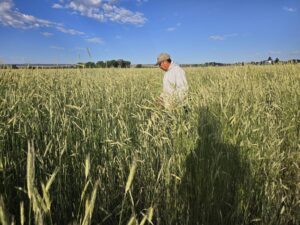
Issues with furrow closure during planting on June 5
Drone view of the plot at planting/ crimping on June 5
Planting pinto beans into the crimped rye on June 5
Cover crop a week after crimping on June 12
Tilled pinto bean field across the lane on July 16
Pinto bean stand 40 days after planting on July 16, emergence was uneven and some beans were sclerotic.
Heavy weed pressure in some of the plots on July 16.
Research outcomes
- Laying out the research plots with flags before the operators planted it was critical.
- Closely follow the development stage of the cover crop for timely biomass sampling.
Education and Outreach
Participation summary:
- Webinar, Organic Dry Beans Roller Crimper Research and Market Opportunities, June 3, 2024. 20 attendees. https://rodaleinstitute.org/events/virtual-qa-organic-dry-beans-roller-crimper-research-market-opportunities/
- Field walk, Organic Dry Beans Roller Crimper Research and Market Opportunities, June 5, 2024. 12 attendees. https://rodaleinstitute.org/events/field-walk-organic-dry-beans/.
We hosted a field walk the day of crimping of the cover crop and planting of the crop. The attendees gathered in the research plots to look at the different cover crops and see the crimper and planter in action.
After touring the research plots we gathered to debrief and talk about marketing needs and opportunities for dry beans in the area.
The combination of webinar and field walk back to back was useful in capturing a broader audience. The webinar also served as an advertisement/ reminder about the field walk which took place 2 days later.
Education and Outreach Outcomes
Education and outreach will start in May 2024
